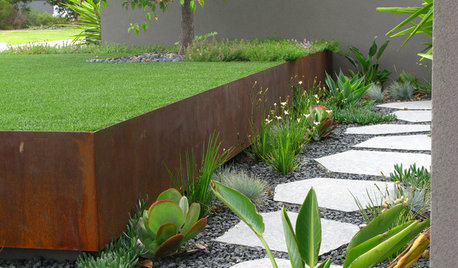Hope you don't mind Newbie Veggie Gardening Questions
marriedcoug
11 years ago
Related Stories

GREEN BUILDINGConsidering Concrete Floors? 3 Green-Minded Questions to Ask
Learn what’s in your concrete and about sustainability to make a healthy choice for your home and the earth
Full Story
FARM YOUR YARDHow to Build a Raised Bed for Your Veggies and Plants
Whether you’re farming your parking strip or beautifying your backyard, a planting box you make yourself can come in mighty handy
Full Story
LANDSCAPE DESIGN7 Questions to Ask Before Laying Stepping Stones
These broken-up pathways invite you to put a spring in your step — while adding functionality to the garden
Full Story
HOUZZ TVHouzz TV: How to Make and Plant a Veggie Box
See how to start edibles from seed, then transfer the seedlings to a box on stilts to make harvesting more fun
Full Story
LIGHTING5 Questions to Ask for the Best Room Lighting
Get your overhead, task and accent lighting right for decorative beauty, less eyestrain and a focus exactly where you want
Full Story
KITCHEN DESIGN9 Questions to Ask When Planning a Kitchen Pantry
Avoid blunders and get the storage space and layout you need by asking these questions before you begin
Full Story
REMODELING GUIDESConsidering a Fixer-Upper? 15 Questions to Ask First
Learn about the hidden costs and treasures of older homes to avoid budget surprises and accidentally tossing valuable features
Full Story
ORGANIZINGPre-Storage Checklist: 10 Questions to Ask Yourself Before You Store
Wait, stop. Do you really need to keep that item you’re about to put into storage?
Full Story
FEEL-GOOD HOMEThe Question That Can Make You Love Your Home More
Change your relationship with your house for the better by focusing on the answer to something designers often ask
Full Story
SELLING YOUR HOUSE15 Questions to Ask When Interviewing a Real Estate Agent
Here’s what you should find out before selecting an agent to sell your home
Full StoryMore Discussions






snowgardener
marriedcougOriginal Author
Related Professionals
Canton Landscape Architects & Landscape Designers · New Bedford Landscape Architects & Landscape Designers · Benbrook Landscape Architects & Landscape Designers · Birmingham Landscape Architects & Landscape Designers · Anderson Landscape Contractors · Chesapeake Ranch Estates Landscape Contractors · Corona Landscape Contractors · Ellicott City Landscape Contractors · Englewood Landscape Contractors · Medford Landscape Contractors · Streamwood Landscape Contractors · The Woodlands Landscape Contractors · East Norriton Landscape Contractors · Camp Springs Landscape Contractors · Berkeley Driveway Installation & Maintenancewertach zone 7-B SC
chas045
zzackey
tetrazzini